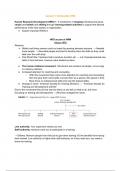Lecture 1: Introduction HRD
Human Research Development (HRD) = A mechanism in shaping individual and group
values and beliefs and skilling through learning-related activities to support the desired
performance of the host system or organization.
● Acquire important KSAO’s
HRD as part of HRM
History HRD
Reasons:
➢ Skilled craft shop owners could not meet the growing demand anymore. → Needed
more people. → Recruited people and tried to develop them the skills so they could
take over the craft shop.
➢ First World War: Factories had to produce munition etc. → Lot of people learned new
skills in thos factories, however were treated as slave.
● The human relations movement: Movement saw workers as people, not as cogs
in a factory machine.
● Increased attention for coaching and counseling
○ With this movement there came more attention for coaching and counseling:
Not only give them some skills, but see them as a person who grows in time.
○ More focus on interpersonal skills (not only the trained skills).
● Change in name: ‘American Society for Training Directors’ → ‘American Society for
Training and Development (ASTD)’
Due to the movement they did not want to direct us and tell us what to do, but more
focussing on training and development → Why they changed the name.
Line authority: Your supervisor needs you now.
Staff authority: Advisors want you to participate in a training.
→ Dillema: Remove people from their job to give them training VS the benefits from having
them trained. Line authority is higher than staff authority, so if they need you, you need to
leave the training.
,Three core functions of HRD
(1) Training and development
● Employee orientation
● Skills training
● Coaching
● Counseling (e.g. sexual harrasement training)
(2) Career development
● Career planning
● Career management
→ Broader perspective, long-term
(3) Organization development
● Increase employees’ effectiveness and well-being through interventions.
The ADImE Model
= A basic HRD framework
Assessment: What kind of skills does the current worker has and what does he still needs to
develop: What are the most important to develop quicker (prioritizing)?
➔ Once you’ve done that you find objectives, develop lesson plan, develop materials,
select trainer, select methods, schedule the program.
Lecture 2: Influences on Employee Behavior
Learning Goals
You will know important factors that influence employee behavior.
You will know what motivation is and why it is important for HRD.
You will know important theories of motivation and how they can be applied to HRD.
, Goals of HRD in an organization:
(1) To assist employees and organizations in attaining their goals.
(2) The ultimate objective is to improve organizational performance.
(3) The major focus of most HRD interventions is an effort to change employee behavior.
Behavior HRD wants to change:
Individual performance is multidimensional
Job Performance = Task Performance + OCB (contextual performance)
➔ Task Performance (in-role behavior):
◆ Behaviors central to doing one’s job.
◆ Mandatory
◆ Most HRD focus
➔ OCB /Contextual performance (extra-role behavior):
◆ Not specific to any task
◆ Discretionary
◆ Also important → E.g. culture of innovation, cooperation, teamwork.
Motivation is key
Key Factors Affecting Employee Behavior
(1) External forces
➔ Outside the organization
◆ E.g. Covid, artificial intelligence, change in aging, immigration, etc.
➔ Inside the work environment (organization)
◆ Leadership
◆ Coworkers
◆ Outcomes (Promotion, Salary)
(2) Internal Forces
= Within employee
● Motivation
● Attitudes
● KSAs ( = Knowledge, Skills, Abilities)
→ Directly influencing the behavior of employees.
→ Model that shows how the factors are influencing employee behavior, leading to different
outcomes.
OUTCOMES:
❖ Occur as a result of a given employee's behavior
2 types of outcomes
1. Personal: Have value to the individual
❖ Payment, recognition, emotions.
, ❖ Avoid embarrassment, disciplinary actions, transfers, loss of pay or privileges,
and ostracism.
2. Organizational: Valued by the organization
❖ Teamwork, productivity, product quality
Why are these important for HRD?
You can make trainings based on this information. When thinking about development, you
take these factors into account. You connect the personal and organizational values: If they
do not match, you need some kind of intervention.
Two theories that expect outcomes:
● Expectancy Theory
● Equity Theory
How can coworkers affect behavior?
● They control some of the outcomes and therefore some of the behavior.
○ E.g. they may offer or withhold friendship and recognition
● Norms set the guidelines for behavior in the group
○ Norm is being productive? The group will be extra productive. Also the other
way around.
● Group dynamics influence the way an employee behaves when interacting with a
group, e.g.
○ Groupthink: Concerned with unanimity rather than making good decisions.
(You don’t want to be different and you want the group to make fast decisions,
as a result, the group is making wrong decisions).
○ Social Loafing: Tendency for individuals to reduce the level of effort as the
group becomes larger.
○ Teamwork issues e.g., trust, cohesiveness
■ Trust is linked to better performance. Cohesiveness also hence
cooperation and effectiveness, however too much cohesiveness leads
to groupthink/ strong social pressure.
MOTIVATION (Internal Influence)
Motivation = One of the most basic elements of human behavior, specifically:
“The psychological processes that cause the arousal, direction, and persistence of voluntary
actions that are goal-directed.”
● Individual Phenomenon: Motivation is unique per person. It depends on needs,
desires, attitudes, goals.
● Voluntary
● Motivation requires 3 processes:
(1) Energizing: You need energy to do it
(2) Direction:
(3) Persistence:
Why is motivation important for HRD?
● To diagnose the cause of performance problems.
● Relates to topics such as employee engagement, work passion, and employee
proactivity.
● To design or choose HRD programs to remedy those problems.





